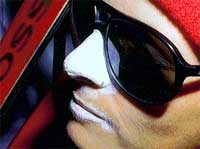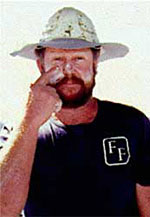

Sunscreen works by combining organic and inorganic active ingredients.
Inorganic ingredients like zinc oxide or titanium oxide reflect
or scatter ultraviolet (UV) radiation. Organic ingredients like
octyl methoxycinnamate (OMC) or oxybenzone absorb UV radiation,
dissipating it as heat. Some sunscreens protect us from the two
types of damaging UV radiation: UV-A and UV-B. Both UV-A and UV-B
cause sunburns and damaging effects such as skin cancer.
Ultraviolet radiation is broken into three types of wavelengths:
- UV-A: This is the longest wavelength and is not absorbed by
the ozone. It penetrates the skin deeper than UV-B.
- UV-B: Responsible for sunburns. It is partially blocked by the
ozone layer.
- UV-C: This is totally absorbed by the earth's atmosphere; we
encounter it only from artificial radiation sources.
 When
purchasing sunscreen, the Sun Protection Factor or SPF measures
how effectively the sunscreen formula limits skin exposure to UV-B
rays that burn the skin. The higher the SPF the more protection
the sunscreen will provide against UV-B rays. SPF does not measure
UV-A. If you are looking for UV-A protection, the experts recommend
that you purchase a product that has broad-spectrum protection. When
purchasing sunscreen, the Sun Protection Factor or SPF measures
how effectively the sunscreen formula limits skin exposure to UV-B
rays that burn the skin. The higher the SPF the more protection
the sunscreen will provide against UV-B rays. SPF does not measure
UV-A. If you are looking for UV-A protection, the experts recommend
that you purchase a product that has broad-spectrum protection.
 Related
Web Sites Related
Web Sites |
- Sunscreen:
How to Select, Apply, and Use it Correctly - The
Center of Disease Control and Prevention provides
a brief list
of sunscreen recommendations.
- American
Academy of Dermatology - The Facts About Sunscreens
Web site gives information about choosing sunscreen, applying
sunscreen, treating sunburns and other questions relating
to protecting your skin from the sun.
- FDA
Aims to Upgrade Sunscreen Labeling -
FDA wants the labeling on your sunscreen to tell you more
about protection against the sun's harmful rays.
- The
Sun, UV, and You - A guide to the UV index and Sun-Safe
Behavior. This Web site from the EPA provides information
about UV, health risks of sun exposure, and how to protect
yourself from the damaging effects of the sun. Also has
a section about ozone depletion.
- Climate
Prediction Center: Current UV Index Forecast - This
Web site provides the UV index at high noon for the United
States.
- UV
Radiation: NASA - NASA Advanced Supercomputing Division
educational resource on ultraviolet radiation contains an
introduction to ultraviolet radiation and the health effects
of UV-B radiation. References are also cited at the end
of the article.
|
 Further
Reading Further
Reading |
- Reisch,
Marc. Sunscreens: active ingredients prevent skin damage.
Chemical & engineering news, v. 80, June 24,
2002: 38. Accessible online at URL: http://pubs.acs.org/cen/whatstuff/stuff/8025sunscreens.html
- Sunscreens:
development, evaluation, and regulatory aspects. Edited
by Nicholas J. Lowe, Nadim A. Shaath, and Madhu A Pathak.
2nd ed. New York, Marcel Dekker, c1997. 792 p.
-
UV-B
radiation and ozone depletion: effects on humans, animals,
plants, microorganisms, and materials. Edited by
Manfred Tevini. Boca Raton, FL, Lewis Publishers, c1993.
248 p.
- United
States. Adequacy of protection from sunglasses and sunscreens:
hearing before the Ad Hoc Subcommittee on Consumer and
Environmental Issues of the Committee on Governmental Affairs,
United States Senate, One Hundred Second Congress, Second
session, June 5, 1992. Washington, U.S. G.P.O., 1993.
294 p.
|
 For
more print resources... For
more print resources...
Search on "sunscreen,"
"uv" and "ultraviolet"
in the Library of Congress Online
Catalog.
|
[Sunscreened
Face]. National Institutes of Health,
National Cancer Institute
 Society leaders
display 200 years of beach attire at Cape May Sun Tan Cabana Club.
Underwood and Underwood, 1931. Prints
and Photographs Division, Library of Congress.
Society leaders
display 200 years of beach attire at Cape May Sun Tan Cabana Club.
Underwood and Underwood, 1931. Prints
and Photographs Division, Library of Congress.
[Australian
man applying sunscreen]. National Institutes of Health, National
Cancer Institute |

 When
purchasing sunscreen, the Sun Protection Factor or SPF measures
how effectively the sunscreen formula limits skin exposure to UV-B
rays that burn the skin. The higher the SPF the more protection
the sunscreen will provide against UV-B rays. SPF does not measure
UV-A. If you are looking for UV-A protection, the experts recommend
that you purchase a product that has broad-spectrum protection.
When
purchasing sunscreen, the Sun Protection Factor or SPF measures
how effectively the sunscreen formula limits skin exposure to UV-B
rays that burn the skin. The higher the SPF the more protection
the sunscreen will provide against UV-B rays. SPF does not measure
UV-A. If you are looking for UV-A protection, the experts recommend
that you purchase a product that has broad-spectrum protection.


